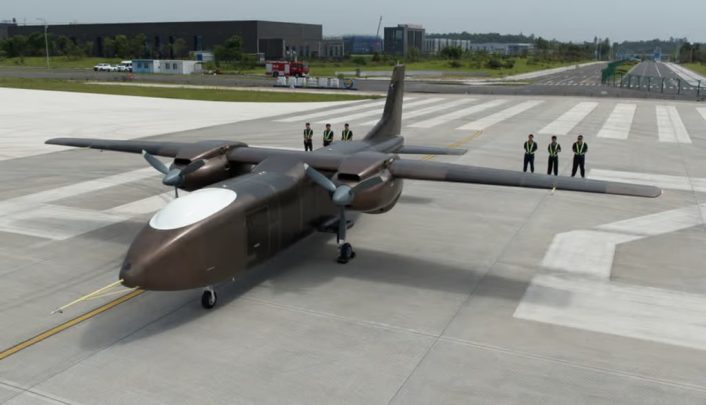China has flown its largest cargo drone to date, marking a significant step in the nation’s growing dominance in unmanned aerial vehicle (UAV) technology.
The new UAV, developed by Sichuan Tengden Sci-Tech Innovation Company, took to the skies on August 11, 2024, from Zigong Lan-Tian airport in Sichuan province.
With this flight, China sets a new record in UAV size and also showcases its potential to revolutionize logistics and military operations.
Sichuan Tengden: A Leader in UAV Innovation
Sichuan Tengden, a company described by Chinese media as a leading player in intelligent aerial vehicle research, has developed this new drone with impressive capabilities.
The UAV has a wingspan of 16.1 meters, a height of 4.6 meters, and can carry a commercial payload of up to 2,000 kg.
This makes it the largest cargo drone ever built in China, surpassing the Feihong FH-98.
Technical Specifications: Built for Heavy Lifting
The UAV’s design is practical and focused on functionality. It features a high-wing, twin-engine configuration, which is conventional yet effective for its intended purposes.
The cargo space measures 12 cubic meters, designed for easy loading and unloading, thanks to two cargo doors on the left side.
These features highlight the drone’s capability to perform in various logistics scenarios, particularly in remote and challenging environments.
Semi-Autonomous Capabilities: The Future of UAVs
One of the standout features of this new UAV is its potential for semi-autonomous or fully autonomous flight.
Equipped with a high degree of intelligence, the drone can navigate through preset waypoints.Making it a robust tool for missions that require precision and reliability.
The large white antenna dome on top of the forward fuselage suggests satellite communication capabilities. While a forward-facing camera installed on the nose could provide real-time visual data during flights.

Image Credits : CCTV
The Feihong FH-98: A Legacy Surpassed
Before this new development, the Feihong FH-98 held the title of China’s largest cargo drone.
Derived from the Y-5B bi-plane and the Soviet An-2, the FH-98 was a significant achievement when it first flew in October 2018.
With a maximum take-off weight (MTOW) of 5.25 tons, a payload capacity of 1.5 tons, and a cargo volume of 15 cubic meters, it set a high standard for UAV performance.
However, its recent crash, coupled with the advancements seen in Sichuan Tengden’s new drone, signals a shift in the UAV landscape.
AVIC’s HH-100: Another Contender in the Race
China’s state-owned Aviation Industry Corp (AVIC) is also making strides in UAV development.
The AVIC HH-100, which performed its maiden flight in June 2024, is another cargo drone that aims to meet the nation’s growing logistics needs.
With a MTOW of 2,000 kg and a payload capacity of 700 kg, the HH-100 is designed as a low-cost, high-payload aircraft.
Its maximum cruise speed of 300 km/h, a service ceiling of 5,000 meters, and a flight radius of 520 km make it a formidable competitor in the UAV market.
The Future of Cargo Drones in China
China’s rapid advancements in UAV technology are not just about setting records; they reflect the country’s broader ambitions in both civilian and military applications.
Sichuan Tengden’s new cargo drone is a clear indication of this trend, offering capabilities that can support a wide range of operations, from logistics to potential military applications.
The UAV’s ability to operate in semi-autonomous modes, coupled with its impressive payload capacity, makes it a versatile tool for various missions.
As China continues to innovate in this field, we can expect to see more developments that push the boundaries of what UAVs can achieve.
Conclusion: A New Benchmark in UAV Technology
The maiden flight of Sichuan Tengden’s latest UAV represents a significant milestone in China’s UAV program.
By surpassing the capabilities of previous models like the Feihong FH-98, this new drone sets a new standard for cargo UAVs in China.
With its advanced features, large cargo capacity, and potential for semi-autonomous operation, it is poised to play a crucial role in the future of logistics and beyond.
China’s commitment to UAV innovation is clear, and as more projects like this come to fruition, the country will likely continue to lead in this rapidly evolving field.
The skies are no longer the limit; they are just the beginning.


































